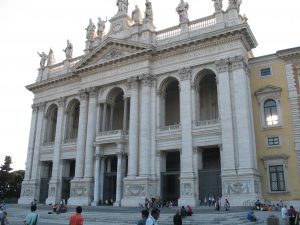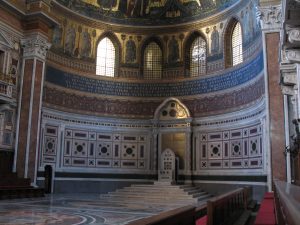FEAST – DEDICATION OF ST JOHN LATERAN
Temples of the Holy Spirit and Life-giving Water
(Ezk 47:1-12; Ps 46; Jn 2:13-22)
*****************************************************
“Wherever this river flows, the waters shall be made fresh.” The readings today, and this feast of the dedication of St. John Lateran, invite us to drink of the living waters of God’s love as temples of the Holy Spirit, and then become rivers of living water for others.
According to The Word Among Us, the Atacama Desert in Chile is one of the driest places on earth. It receives an average of only 0.6 inch of rain per year. Some places it hardly ever rains – one place has not received rain for over 400 years. On a single day in March, 2015, however, thunderstorms brought nearly a full inch of rain and the desert miraculously bloomed. Seeds, dried up and dormant for years, exploded into a burst of life and color. The lifeless, dusty and unappealing land suddenly became a place of beauty and fruitfulness. All this because water brought life to barren salty ground.

St John Lateran
The church of St John Lateran was dedicated by Pope Sylvester I in 324. Originally known as the Archbasilica of the Most Holy Savior, it is called St John Lateran because it was built on property owned by the Laterani family and given to the church. This church is the cathedra (chair) of the bishop of Rome. A Latin inscription reads “Omnium ecclesiarum urbis et orbis mater et caput” (The Mother and head of all churches of the city and the world). Accordingly, the whole church celebrates its dedication.
It’s domed apse contains a magnificent mosaic featuring the river of life described in today’s first reading. It has long been considered the headwaters for the grace that flows to all the churches throughout the world. It is one of the four churches that the world’s bishops visit to celebrate the Eucharist on their regular ad limina journeys to Rome. In the sanctuary is a huge presider’s chair used only by the current pope as the bishop of Rome.

SJL papal chair
The prophet Ezekiel uses this image of life-giving water to give us a message of hope: God can bring life into the deadest and darkest places of our lives that we all experience. A grade eleven student in my first mission, Beauval, once gave me a card that read, intriguingly and to my surprise, “May the Lord shine his light into the dark places of your soul!”
Perhaps that dark and even dead place is a broken relationship, desolation in prayer, someone we know who is suffering, or our powerlessness to change a frustrating situation in our lives. Whatever our desert may be, we can be assured that God wants to bring refreshing, healing and life-giving water there. Ezekiel saw this water flowing out from the Temple, God’s dwelling place. But St. Paul, in the optional first reading, reminds us that we are all temples of God and that the Holy Spirit already lives in us (1 Cor 3:16-17). We have only to quiet ourselves, step out in faith and invite the Holy Spirit to flow through us, penetrate our dark, dry areas and revive them. We need to be patient, give God time and trust in God’s love, and our dry places can come to life.
The gospel for this feast stands in stark contrast to the other readings and the psalm that speaks of streams that gladden the city of God. It is near the Passover, when animal sacrifice in the temple will take place, virtually rendering it a butcher shop. One of the roles that Jesus had as the Messiah was to restore the temple to its former glory. What Jesus encountered when he entered the temple, especially at that time, was crass commercialism. Merchants were selling animals and doves at inflated prices people had to pay to ensure they were “pure.” The money exchangers were charging an exorbitant commission because only the Jewish shekel and not the Roman denarius was considered pure.
This practice took place in the court of the Gentiles, making it virtually impossible for them to pray. This system became so corrupt in the time of Ezekiel that the “shekinah,” or glory of God, lifted up and abandoned the temple. No wonder Jesus drove out the merchants and upset the money vendors. He would restore the temple, not just by this action, but by his death and resurrection as the true temple of God (“Destroy this temple, and in three days I will raise it up.”)
Not only did Jesus restore the glory of the temple, he did it, as St Paul alludes, by bestowing the Holy Spirit, not on the physical temple, but on his disciples gathered in the upper room, in the form of a wind that shook the house and tongues of fire that transformed the fearful band of our ancestors in the faith into a fearless church that has proclaimed this amazing good news to this day.
The Eucharist is our faith experience of that same shekinah or glory of God. We ponder the word of God, then humble gifts of bread and wine are transformed into the body and blood of Jesus through the power of the Holy Spirit. Equally awesome is that we who receive are in turn transformed into the Body of Christ.
Having received this living water from the temple of the Holy Spirit, we are in turn mandated to go out and be rivers of living water for our brothers and sisters most in need. Similar to the early disciples, we remember what Jesus said, believe in his Word, and now must become channels of his life-giving grace for the world.



